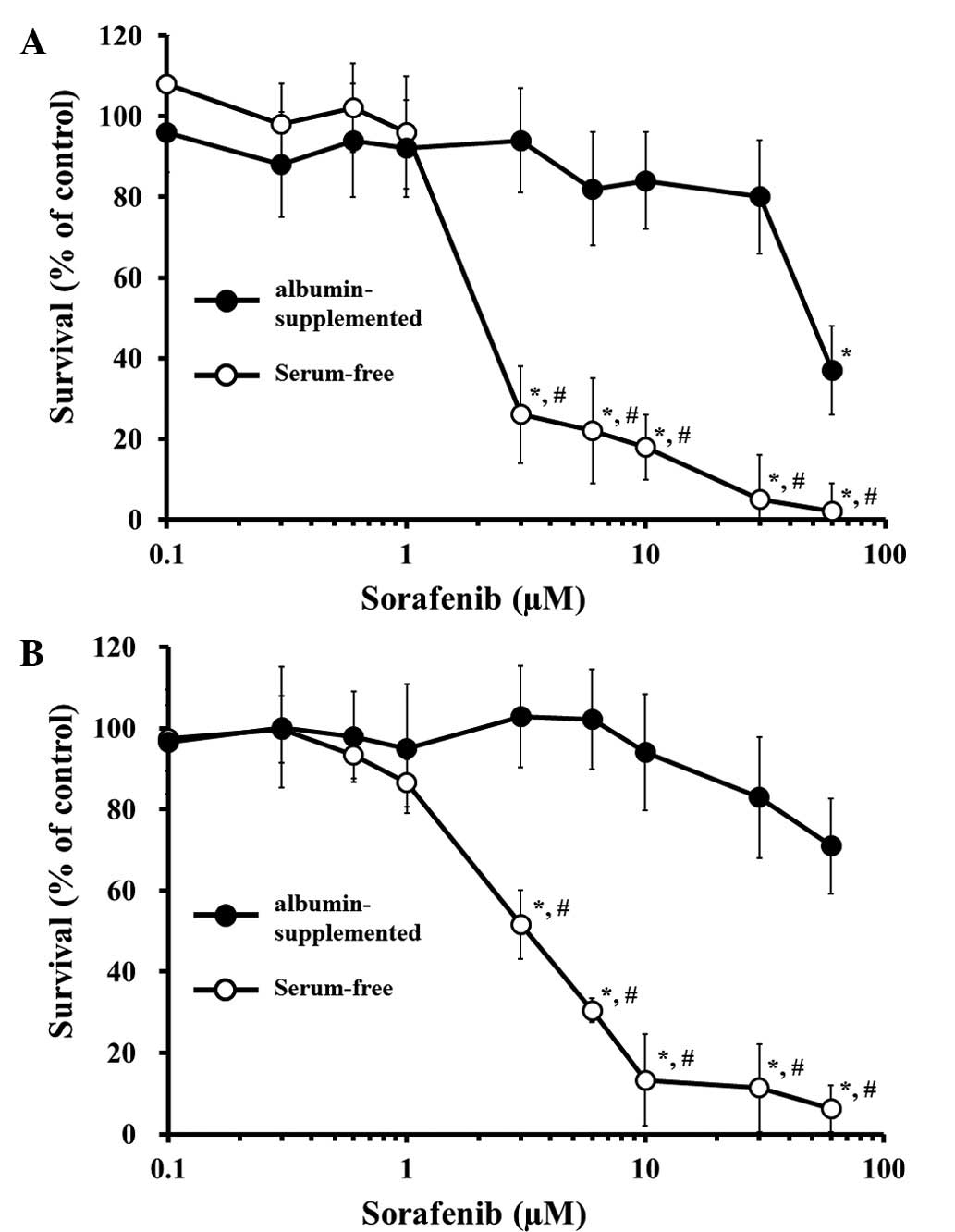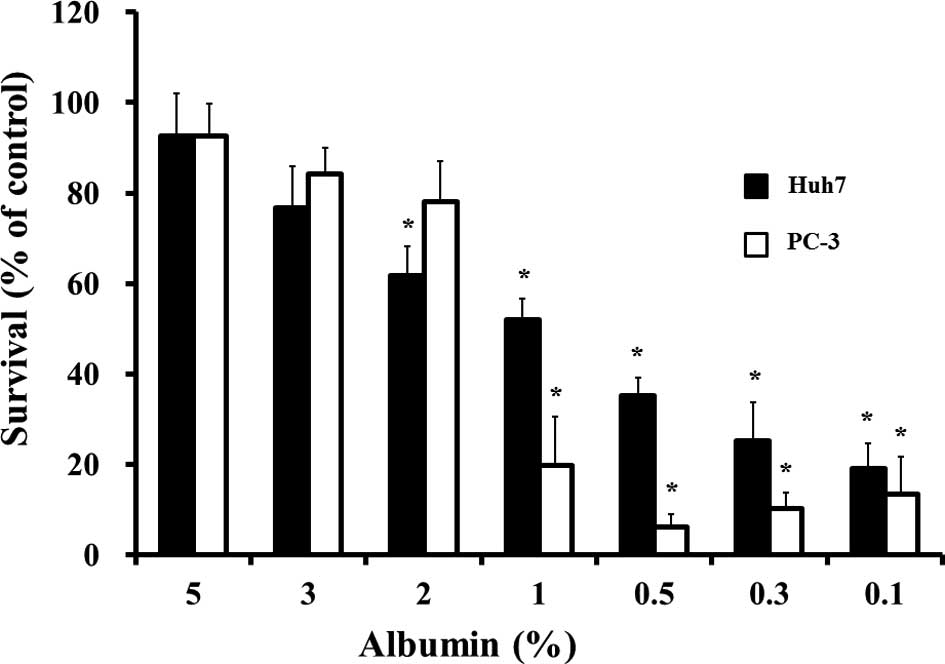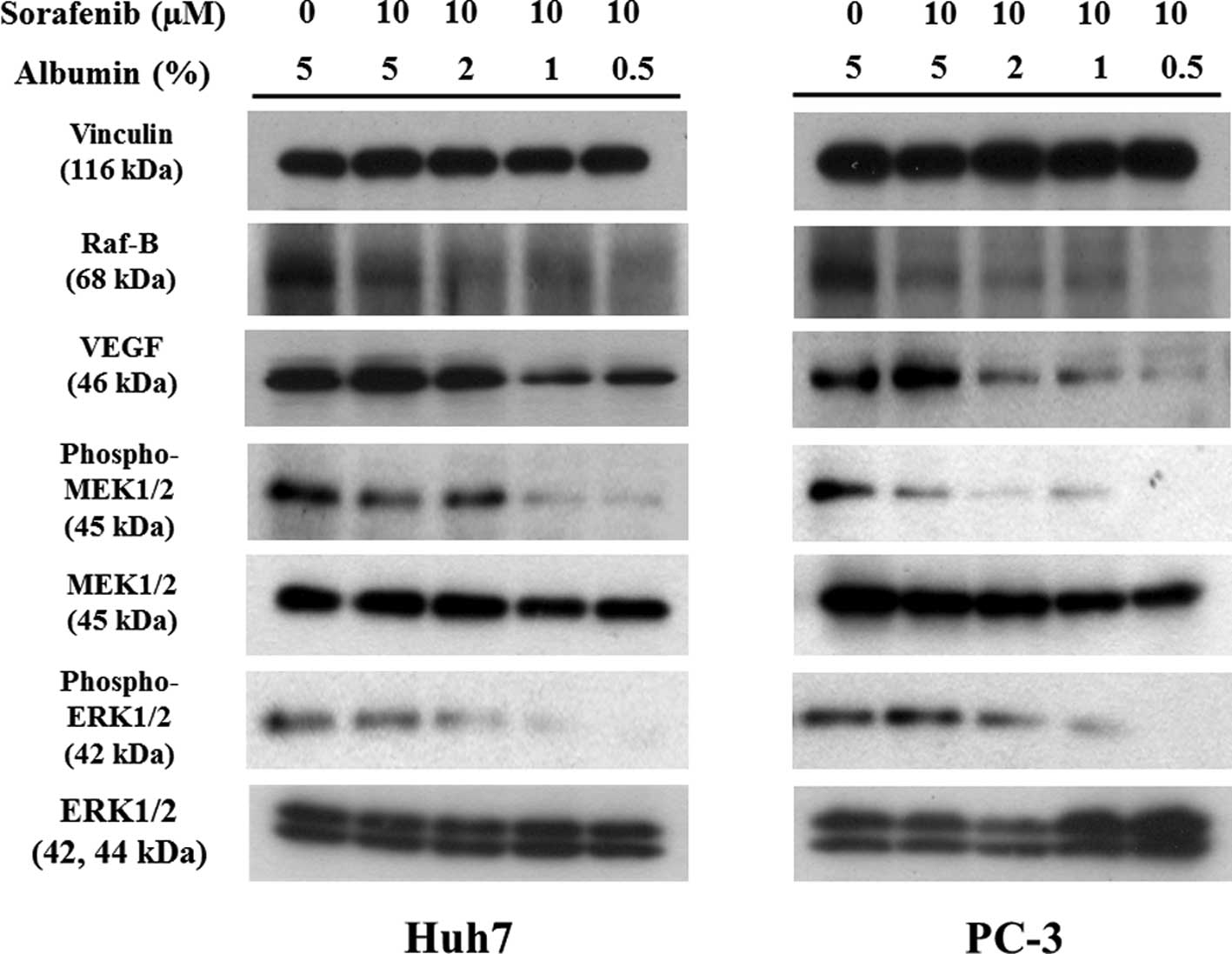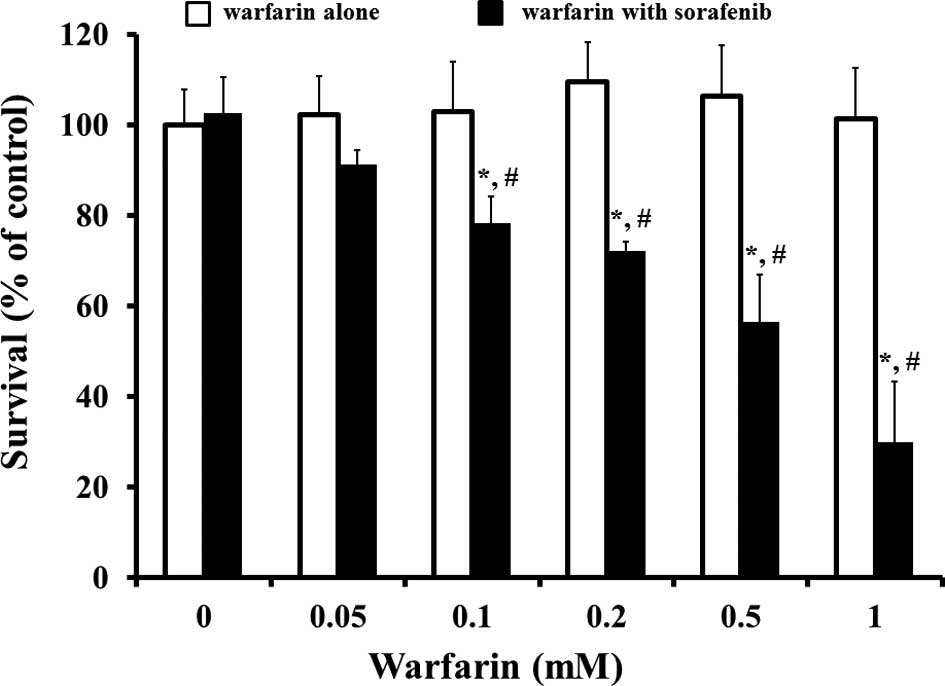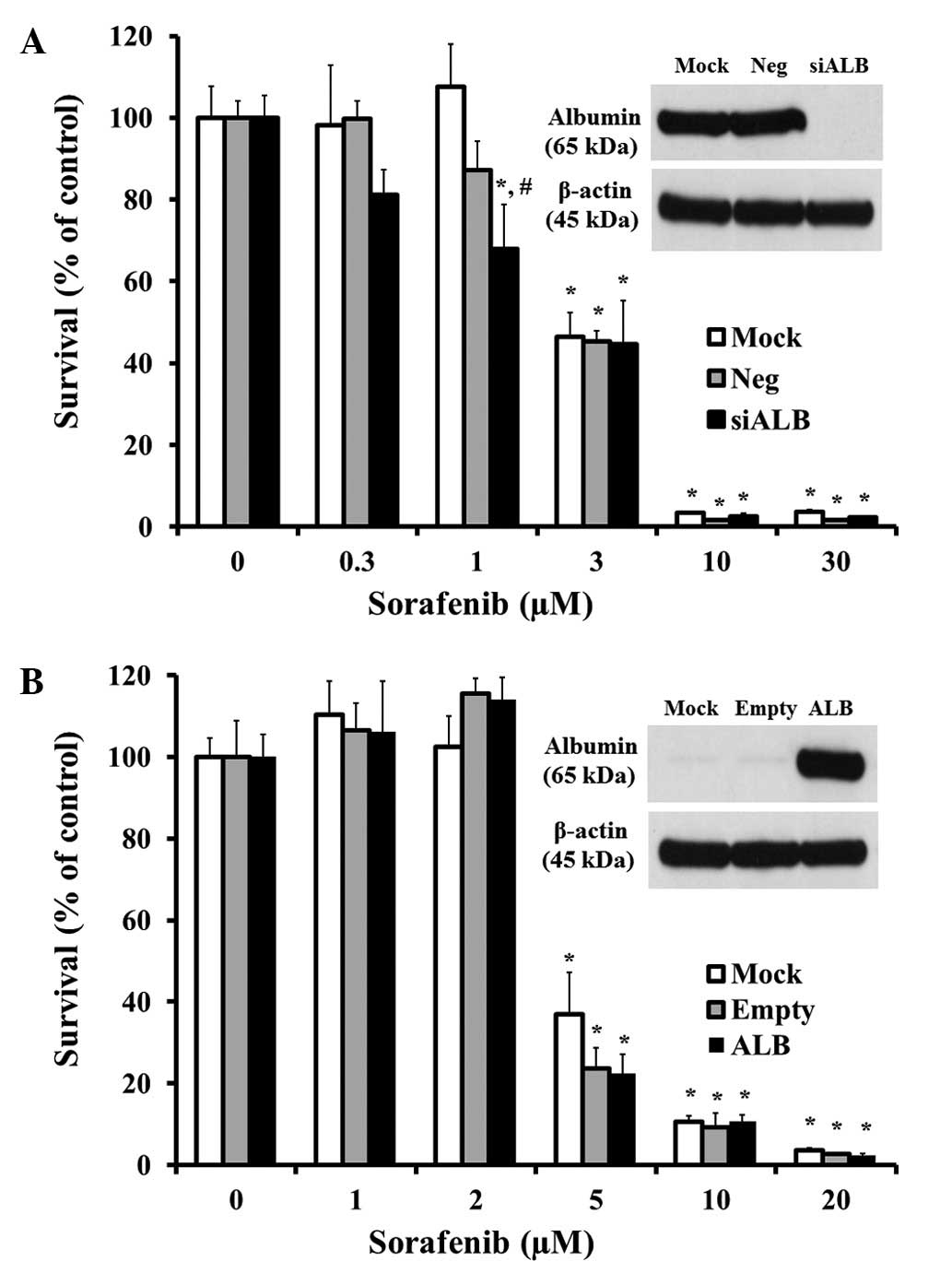Exogenous albumin inhibits sorafenib-induced cytotoxicity in human cancer cell lines
- Authors:
- Published online on: June 27, 2012 https://doi.org/10.3892/mco.2012.3
- Pages: 29-34
Abstract
Introduction
Albumin is the most abundant plasma protein synthesized primarily by liver cells. It is important in regulating blood volume by maintaining the oncotic pressure and also serving as a carrier for various molecules of low water solubility and transport drugs. This highly soluble protein is present in human plasma at a normal concentration between 35 and 50 g/l (1). The half-life of albumin is approximately 19 days and accounts for at least 10% of liver protein synthesis. This suggests that 10–15 g of albumin is produced per day in healthy subjects (2). Serum albumin concentrations below the normal range occur in a variety of disorders. Among these disorders are those associated with malnutrition and malabsorption, where protein is either not consumed in the diet or is lost through the gastrointestinal tract (3). Subsequently, a decrease in albumin concentration is frequently observed in patients with liver disorders (4), and plasma albumin is also reduced in cancer (5) and sepsis (6). Specifically, in nephrotic syndrome or protein-losing gastroenteropathy, plasma albumin is highly reduced to <20 g/l due to excessive albumin loss in urine or incomplete albumin synthesis (7). Thus, lower serum albumin (i.e., hypoalbuminaemia) is likely to be affected by a higher binding affinity of certain drugs with albumin.
Sorafenib, 4-pyridine 2-carboxylic acid methylamide 4-methylbenzenesulfonate, is an orally administered multikinase inhibitor that exhibits anti-angiogenic and anti-tumor activity (8). This activity is caused by targets in the kinase domains of vascular endothelial growth factor (VEGF), platelet-derived growth factor (PDGF) and inhibition signaling through the RAF kinases, including Raf-1 and Raf-B, or RAF/mitogen-activated protein (MAP)/extracellular signal-regulated kinase (ERK) kinase (MEK)/ERK (RAF/MEK/ERK) cascade (9,10). Sorafenib as a single agent has demonstrated preclinical and clinical activity against several types of tumorxx (11–15). Sorafenib is known to bind to protein (>99.5%) and has a low hepatic extraction ratio, suggesting that protein binding is important in sorafenib pharmacokinetic variability (16). Thus, variations in sorafenib binding may contribute to the variability in sorafenib exposure. A recent study reported the characterization of in vitro sorafenib binding properties to albumin and the effect of albuminemia on sorafenib clearance and its disposition in cancer patients (17). Similar reports have shown that sorafenib is highly protein-bound in human plasma with a higher affinity towards albumin and that limited free drugs may play a role in its borderline clinical activity (18).
In this study, we examined the effect of both extracellular (exogenous) and tissue (endogenous) albumin on sorafenib-induced cytotoxicity using two major in vitro culture cell lines, human hepatoma Huh-7 cells and androgen-independent prostate cancer PC-3 cells. In addition, we evaluated the cytotoxic effects of drug interaction with sorafenib and warfarin, both of which exhibited a high affinity for albumin. This is the first report to show that predominantly exogenous albumin inhibits sorafenib-induced cytotoxicity resulting from its extracellular binding properties. These data may be useful in the clinical application of sorafenib.
Materials and methods
Materials and cell culture
Sorafenib was purchased from Toronto Research Chemicals Incorporated (Ontario, Canada). Sorafenib was dissolved in dimethyl sulfoxide (DMSO) and final concentrations were prepared on the day of use from a stock solution. A concentration range of 0.1 to 60 μM was typically used in the different experiments. Albumin, from human serum (catalog no. A1653, Sigma, St. Louis, MO, USA) and all other reagents, unless otherwise stated, were of the highest grade available and were purchased from either Sigma or Wako Pure Chemical Industries, Ltd. (Osaka, Japan). Cells were supplied by the Cell Resource Center for Biomedical Research, Tohoku University (Sendai, Japan). The cells were routinely cultured using standard methods as described in our previous report (19) Research protocols were approved by the Ethics Committees of Tohoku Pharmaceutical University.
MTT assay
Cytotoxicity was assessed by the MTT [3-(4,5-dimethylthiazol-2-yl)-2,5-diphenyl tetrazolium bromide] assay, a modification of our previously described method (20). Briefly, cells were seeded at 5×103 in 96-well plates and cultured overnight. The cells were washed with serum-free medium. The medium was removed and replaced with or without 4% albumin contents in serum-free media. The cells were then incubated with sorafenib for 48 h, followed by the addition of 10 μl MTT (5 mg/ml saline) to each well. Samples were incubated for 90 min at 37°C, the supernatant was aspirated, and the cells were lysed and solubilized by the addition of 100 μl of 0.04 N HCl in isopropanol. The absorbance of each well was determined at 590 nm using an Inter-med model NJ-2300 Microplate Reader. The control cells were treated with 0.5% DMSO (sorafenib vehicle). Cell viability was calculated using the formula: absorbance in treated sample/absorbance in control ×100 (%).
Western blotting
The effects of signal transduction by sorafenib or confirmation of the transfected assay were estimated by western blotting (21). Briefly, the cells were washed with PBS and lysed in CelLytic M (Sigma), according to the manufacturer’s instructions. Samples of each protein (30 μg) were loaded onto a 10% SDS-polyacrylamide gel. After electrophoresis, the protein was transferred to a polyvinylidene difluoride (PVDF) membrane. The protein was blocked with blocking solution (25 mM Tris-HCl, pH 7.4, 137 mM NaCl, 2.68 mM KCl and 5% skim milk) for 4 h and reacted with antibody overnight at 4°C. The membrane was then washed with blocking solution without skimmed milk, and incubated with horseradish peroxidase-linked secondary antibody for 1 h. After another wash, the protein levels were analyzed by enhanced chemiluminescence with an ECL plus western blotting detection system (Amersham, Arlington Heights, IL, USA). The primary antibodies used were: VEGF (Calbiochem, Darmstadt, Germany) and Raf-B (Santa Cruz Biotechnology, Inc., Santa Cruz, CA, USA). Albumin and any other antibodies were from Cell Signaling (Beverly, MA, USA).
Transfection studies
siRNA-albumin (siALB) and siRNA-control as non-targeting siRNA (Negative control: Neg) were transfected into Huh-7 cells using HyperFect transfection reagent (Qiagen, Valencia, CA, USA) according to the manufacturer's instructions. A non-targeting siRNA was used as a control for the non-sequence-specific effects of the transfected siRNAs. The siRNAs (Qiagen) used were siALB from GeneSolution siRNA (catalog no. 1027416) and negative control from AllStars negative control siRNA (catalog no. 1027281). Briefly, Huh-7 (1×105) cells containing each siRNA (final concentration, 40 nM) and HyperFect reagent were incubated for 24 h, assessed by western blotting using the expression of β-actin as the control and their cytotoxic effects were evaluated by sorafenib.
The albumin was overexpressed using the vector established in our previous study (19). PC-3 cells were transfected with pcDNA 3.1 plasmid DNA alone (empty) or containing Albumin cDNA (ALB) using Lipofectamine™ LTX reagent (Invitrogen, Carlsbad, CA, USA) according to the manufacturer's instructions. After being cultured for 24 h without antibiotics, the transfected cells were examined for western blotting using the expression of β-actin as the control or using the cytotoxicity assay.
Statistical analysis
Statistical analysis of the results was performed using a one-way analysis of variance (ANOVA) followed by the Williams' type multiple comparison test or a Bonferroni test among multiple groups. P<0.05 was considered statistically significant.
Results
Comparison of the effect of cells supplemented with or without albumin in serum-free media on sorafenib-induced cytotoxicity
Albumin is contained in the serum of culture media. To explore the essentially exogenous albumin by sorafenib-induced cytotoxicity, we examined the human hepatoma Huh-7 or prostate cancer PC-3 cells, supplemented with or without albumin in serum-free media. To perform the assessment of exogenous albumin in this assay, a concentration of 4% of normal physiologically serum content was used. The concentration of sorafenib up to 1 μM exhibited no cytotoxic effect on the two cell lines whether or not they were albumin-supplemented or serum-free (Fig. 1A and B). The cell lines were relatively robust to cell stress since when the serum was removed from the culture media, no spontaneous apoptotic effects were observed in the culture for 48 h (data not shown). In serum-free conditions of >1 μM, sorafenib showed a significant concentration-dependent cytotoxic effect in the two cells. By contrast, albumin-supplemented conditions potently inhibited the cytotoxic effect of sorafenib up to 10 or 30 μM in Huh-7 or PC-3 cells, respectively. The calculated 50% cell growth inhibition (IC50) of serum-free or albumin-supplemented conditions in Huh-7 was 1.628 or 44.62 μM, and 3.319 or 153.7 μM, respectively, in PC-3. Thus, the presence of exogenous albumin markedly blocked the sorafenib-induced cytotoxicity in the two cells.
Concentration-dependent effects of exogenous albumin on sorafenib-induced cytotoxicity
We examined the concentration-dependent effect of exogenous albumin on 10 μM sorafenib-induced cytotoxicity in Huh-7 or PC-3 cells. Exogenous lower albumin <2% in Huh-7, or 1% in PC-3, respectively, exhibited an increased concentration-dependent cytotoxic effect after 10 μM sorafenib was added in each of the cells (Fig. 2). Western blotting was used to confirm the lower albumin concentration on the pharmacological pathway of signal transduction by sorafenib in the two cells (Fig. 3). No change was observed in the expression of vinculin as the control or total MEK1/2 or ERK1/2 proteins as each signal control. However, previous reported changes of signal proteins, such as Raf-B, VEGF and the phosphorylation of MEK1/2 or ERK1/2, following incubation with 10 μM sorafenib, correlated with the decrease in co-incubation with albumin in a concentration-dependent manner. Accordingly, these changes suggest that the reduction of cell survival and the concentration of exogenous lower albumin may drive the effect of sorafenib.
Drug interaction with warfarin and sorafenib on cell survival reduction
Warfarin, a representative coumarin anticoagulant is known for its interaction with numerous drugs. This drug has potent binding activity with albumin. As stated above, the effect of sorafenib pertains to exogenous albumin. Thus, we examined the effect of warfarin on 3 μM sorafenb-induced cytotoxicity in Huh-7 cells with albumin-supplemented conditions (Fig. 4). A single incubation with warfarin up to 1 mM did not show any cytotoxic effect on Huh-7 during the 48 h culture. Co-incubation with warfarin of >0.05 mM and sorafenib at 3 μM showed a significant warfarin concentration-dependent increase in the reduction of cell survival. Similarly, warfarin was found to potentiate the cytotoxic effect of sorafenib in PC-3 cells (data not shown).
Effects of endogenous albumin on sorafenib-induced cytotoxicity
In the physiological conditions, albumin exists in extracellular (exogenous) form as serum and in intracellular form on tissues (endogenous). Furthermore, we investigated the effect of endogenous albumin expression on sorafenib-induced cytotoxicity using a siRNA knock-down system in Huh-7 cells or the transfected expression vector assay in PC-3 cells (Fig. 4A and B). In the Huh-7 hepatoma cells, the constantly expressed albumin protein was derived from liver tissues, and the albumin expression was almost completely knocked down by transfection with siALB (Fig. 5A). Incubation with sorafenib at 0.3 to 30 μM has shown a concentration dependent cell survival reduction in mock (not transfected with siRNA), siNeg (transfected with non-specific siRNA as negative control) and siALB Huh-7 cells. However, no significant changes occurred in the transfected cell conditions, with the exception of incubation with 1 μM sorafenib in the siALB cells. Prostate cancer as PC-3 did not entirely express the albumin protein in the usual culture state, whereas the introduction of the albumin expression vector apparently overexpressed albumin in this study (Fig. 5B). Similarly, these cells exhibited concentration-dependent cytotoxic effects by sorafenib, but there were no differences regarding whether or not they were transfected with the albumin vector. These data indicated that tissue albumin rarely affects sorafenib-induced cytotoxicity.
Discussion
Sorafenib is known to bind to albumin resulting in a strong effect on sorafenib clearance in albumine mia and therefore on its disposition in adult cancer patients with advanced solid tumors (17,18). In several pathological states, endogenous ligands may accumulate to relatively high concentrations able to displace drugs highly bound to albumin, resulting in a significant increase in the unbound fraction of drugs (22). Patients with advanced solid tumors frequently exhibit denutrition and they have severe renal or hepatic impairment. Under those circumstances, hypoalbuminemia, hypertriglyceridemia or hyperbilirubinemia may occur. Therefore, an increase in sorafenib unbound fraction resulting in an enhanced clearance should be expected. This study demonstrates that exogenous albumin inhibits sorafenib-induced cytotoxicity in human cancer cell lines. This result suggests that in the case of serious side effects, depending on the higher plasma concentration of sorafenib in cancer patients following sorafenib treatments, exogenous albumin may be used as an antidote drug for overdose of sorafenib. In serum-free media, albumin is often used instead of fetal bovine serum in the cell culture media, improving the performance of a wide range of cell types, including stem and primary cells (23). Thus, albumin is added to the cell culture media as a supplement to increase the growth and productivity of cells (24). Our in vitro study may not completely reflect cell growth, but the albumin-supplemented groups did not show any change, compared with the usual culture conditions in the experimental period.
The cytotoxic effect of sorafenib has shown a statistically significant increase below the concentration of 2% albumin compared with the 5% albumin-supplemented conditions (Fig. 2). In clinical cases, however, a 2% albumin concentration in plasma is regarded as a serious pathological event. Despite the enhanced effect of a lower concentration of albumin in our experimental study, the use of sorafenib may be used in cancer patients with albuminemia. A decrease in the expression in Raf-B and the phosphorylation of MEK by sorafenib showed no change for either the 5 or 2% albumin concentration in the two cells (Fig. 3). These results suggest that sorafenib inhibits kinase activation without exhibiting significant cytotoxic effects. In contrast to standard antineoplastics, sorafenib was also shown to be suitable for long-term administration due to its good safety profile (25). Currently, sorafenib is approved for the treatment of patients with advanced renal cell carcinoma and those with hepatocellular carcinoma. In this study, we used two distinct human cancer cells, hepatoma and prostate cancer. Patients with metastatic androgen-independent prostate cancer have a poor prognosis with few therapeutic options, all of which are palliative. The effect of sorafenib on PC-3, a hormone refractory, metastatic prostate carcinoma cell line was also examined. In their study, Ullén et al indicated that sorafenib induced apoptosis and autophagy in two hormone refractory prostate cancer cells in vitro, including PC-3 (26). Our results partly supported previous data which showed that sorafenib can be widely applied in other tumor types. As shown in Fig. 4, co-incubation with warfarin enhanced the sorafenib-induced cytotoxicity; however, the experimental concentration of warfarin used in this study was much higher than that of the clinical plasma concentration at almost 567.6±123.3 ng/ml (1.72±0.37 μM) (27). Although no serious side effects of the interaction between sorafenib and warfarin have been known to occur in clinical patients, the combination should be used with care. Of note, combined use of sorafenib with warfarin is written as ‘attention’ on the information provided in the NEXAVAR® (sorafenib) package insert.
Drug distribution is a function of both plasma protein and tissue protein bindings. One of the physiological actions of albumin involves transporting drugs. If tissue albumin attracts or blocks sorafenib in its high affinity towards albumin, it may serve as a good target or delivery carrier for cancer chemotherapy. Thus, we hypothesized that change in tissue albumin may affect sorafenib-induced cytotoxicity. In contrast to our expectation, sorafenib-induced cytotoxicity has changed little in tissue albumin, regardless of whether or not albumin was overexpressed or knocked-down in experimental cells (Fig. 5A and B). Currently, no reports are available examining the cancer chemotherapeutic drug effects of the change of tissue albumin. Thus, the cytotoxic effect of sorafenib is not likely to be correlated with the expression of tissue albumin as existing cancer chemotherapeutic drugs.
In conclusion, sorafenib-induced cytotoxicity is inhibited by extracellular albumin but not tissue albumin in human cancer cell lines. These mechanisms depend on the high-bound properties of sorafenib and exogenous albumin. Our results suggest that in case of serious side effects in cancer patients receiving sorafenib treatments, exogenous albumin may be used as an antidote drug for overdose of sorafenib. However, even then care should be taken when adminstering a combined use of drugs with high-bound affinity towards albumin, such as warfarin, in cancer patients with albuminemia. Therefore, our findings may be useful in the cancer therapeutic strategy by sorafenib.



